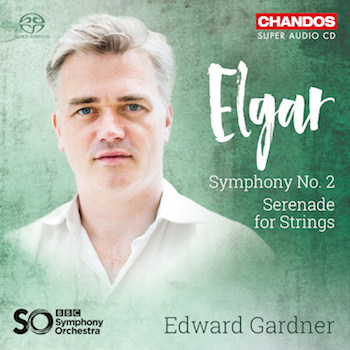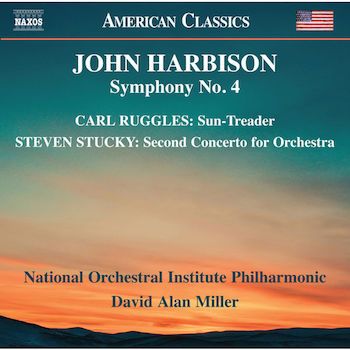Classical CD Reviews: Gardner’s Elgar, Francois-Xavier Roth’s Ravel, and Orchestral Music by Ruggles, Stucky, and Harbison
Strong discs from Edward Gardner and the BBC Symphony Orchestra, Francois-Xavier Roth and his Paris-based period-instrument ensemble Les Siècles, and the National Orchestral Institute Philharmonic, an ad-hoc summer orchestra comprised of some of the U.S.’s finest conservatory musicians.
By Jonathan Blumhofer

Whither Elgar’s Second Symphony? If you live on these shores, that’s a valid question, as neither of that composer’s symphonies have gained a strong foothold in the repertoire of American orchestras. But the British know what they’ve got and Edward Gardner’s new Chandos recording of the piece with the BBC Symphony Orchestra (BBSO) has precious few weak spots.
It is, above all, beautifully played. Textural transparency is the name of the game, whether that be in the busy episodes of the opening movement, the staggering orchestrational invention of the second, or the tripping rhythms of the third. Suffice it to say, all of the score’s little details tell, and each are played with character.
Gardner paces the Symphony’s musical argument well. His take on the first movement is warm and plenty nostalgic, especially in its many quieter moments, which features some particularly refulgent woodwind playing. The second movement is a hair on the faster side but still steeped in sad nobility. In the Rondo, he draws playing of rhythmic bite and menace from the BBCSO, while the finale wistfully recounts the Symphony’s prior materials and winds its way to a luminous coda.
Throughout, Gardner’s interpretation of the piece is well-proportioned, neither getting lost in the music’s sprawling details nor giving in to Elgar’s sometimes-prosaic rhythmic writing (in the first movement, especially). It adds up a fresh entry in the Elgar discography and nicely complements his fine, earlier recording of the First Symphony (also on Chandos).
Filling out the album is an elegant performance of the Serenade for Strings, a lyrical early-ish Elgar score. In it, the BBCSO strings’ sound is polished and vibrant, with the soaring central “Larghetto” providing a fervent contrast to the pert outer movements.

As Gardner knows his Elgar, so conductor Francois-Xavier Roth has a strong handle on the music of Ravel. Roth’s latest recording (on Harmonia mundi) with Les Siècles, his Paris-based period-instrument ensemble, pairs two of the French composers most striking creations – the complete Mother Goose ballet and Le tombeau de Couperin – with his obscure 1898 Shéhérazade Overture.
In terms of pacing, both of the familiar works receive performances that are fluent and richly colored. The delicate woodwind and percussion writing in Mother Goose — the flute solos in the “Pavane,” the harp-celesta-xylophone scoring in “Laideronette,” clarinet solos in the waltz for “la Belle et le Bête” — is strongly etched. And the string textures are delicately rendered, especially in the opening of the final “Apothéose.”
Textural transparency marks Les Siècles playing in Le tombeau de Couperin, Ravel’s memorial to friends lost in World War 1. The exchanges of the opening movement brim with vigor, while the “Forlane” gambols with sour charm. Roth leads an elegant reading of the “Minuet,” highlighted by a gorgeous account of the involved oboe solo, and the concluding “Rigaudon” is a lark.
The Overture, which Ravel withdrew after its first performance and was only published in 1975, charms. Yes, it’s the work of a young composer, too long and a bit obvious in some of its debts, but hints of Ravel’s mature voice peek through and the scoring is assured.
Throughout, Roth’s tempos are smart and he draws out a good number of shadings from Ravel’s ever-inventive orchestrations. Still, to my ears the warmer palette of a non-period orchestra fits Mother Goose better than Les Siècles’ gut strings and narrow-bored woodwinds. Whatever purity of tone and texture such instruments provide doesn’t compensate for moments of scrawny tone. For Shéhérazade and Le tombeau de Couperin, though, there’s little ground for complaint: the ensemble delivers a blazing reading of the latter and a lively one of the former.

The third release of the National Orchestral Institute Philharmonic (NOIP), an ad-hoc summer orchestra comprised of some of the U.S.’s finest conservatory musicians, picks up right where the second left off. Which is to say, with a bracing dose of American orchestral music played with blazing electricity.
You get this right from the start of this Naxos’ album’s opener, Carl Ruggles’ Sun-Treader. A thorny, dissonant work finished in 1931, Sun-Treader is cut from a similar stylistic cloth as Varese’s Amériques and Bartók’s Miraculous Mandarin, though it’s less programmatic in content.
The NOIP isn’t challenged by the score’s angular melodic writing or intimidated by its dense, dissonant textures. Quite the opposite: conductor David Alan Miller draws a reading from the ensemble that is as conspicuous for its warmth and lyricism as it is for the decibel levels produced at Sun-Treader’s climaxes.
The disc’s other two works, Steven Stucky’s Second Concerto for Orchestra and John Harbison’s Symphony no. 4, are more recent, both dating from 2004. Stucky’s Pulitzer Prize-winning score, composed for the inaugural season of the Los Angeles Philharmonic’s Walt Disney Concert Hall, gets its first commercial recording here.
Fragments of melodies shift in and out of focus in its opening movement, “Overture (with Friends).” The second-movement variations are an extended essay in idiomatic writing for orchestra, full of particularly brilliant scoring for winds and brasses, plus breathtaking transitions between each of the six variations. And the finale builds in energy and excitement as it proceeds.
Throughout, the NOIP plays with extraordinary technical skill, a strong sense of the score’s architectural shape, and spades of color. If it’s a shame that this piece needed to wait fourteen years for its debut recording (and it is), we can at least be somewhat comforted in knowing that the NOIP is playing at a level on par with (or at least very near to) what we could have expected from the Los Angelenos fourteen years ago.
As for the Harbison, it receives a lucid, vibrant reading. Rhythms are taut and bursting in the opening movement, “Fanfare.” The “Intermezzo”-second features a series of excellent solo dialogues passed between violin, cello, English horn, and oboe. Harbison’s neo-Stravinsky-ian writing for winds and brasses jumps off the page in the outer frames of the “Scherzo,” while the acid dissonances of the introspective central section are played with biting resonance.
Miller draws straightforward, intense accounts of the last two movements (“Threnody” and “Finale”) from his ensemble; the latter bristles, especially as it reaches its denouement.
What’s one left to say? I’ve got no complaints about these performances or interpretations: all are well-judged and excellently played. Indeed, I’ve had my reservations about the Harbison, but Miller’s is an interpretation that’s gone a long way to causing me to rethink them. In all, then, a persuasive, invigorating release.
Jonathan Blumhofer is a composer and violist who has been active in the greater Boston area since 2004. His music has received numerous awards and been performed by various ensembles, including the American Composers Orchestra, Kiev Philharmonic, Camerata Chicago, Xanthos Ensemble, and Juventas New Music Group. Since receiving his doctorate from Boston University in 2010, Jon has taught at Clark University, Worcester Polytechnic Institute, and online for the University of Phoenix, in addition to writing music criticism for the Worcester Telegram & Gazette.
